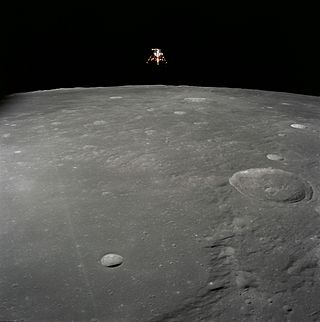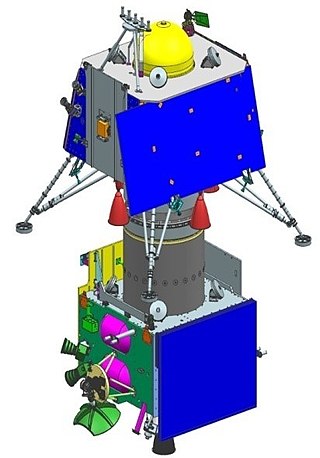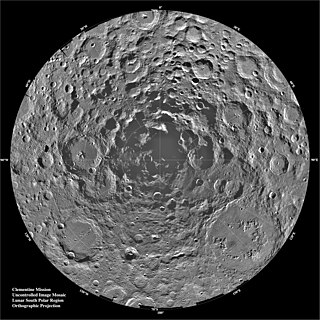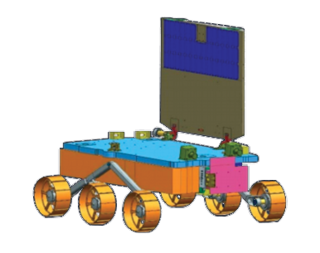
A lander is a spacecraft that descends towards, then comes to rest on, the surface of an astronomical body. In contrast to an impact probe, which makes a hard landing that damages or destroys the probe upon reaching the surface, a lander makes a soft landing after which the probe remains functional.

The Indian Space Research Organisation, commonly referred to as ISRO, is the national space agency of India. It operates under the Department of Space (DOS) which is directly overseen by the Prime Minister of India, while the Chairman of ISRO also acts as the executive of DOS. ISRO is primarily responsible for performing tasks related to space-based applications, space exploration, international space cooperation and the development of related technologies. It is one of the six government space agencies in the world which possess full launch capabilities, deploy cryogenic engines, launch extraterrestrial missions and operates a large fleet of artificial satellites.

Chandrayaan-1 was the first Indian lunar probe under the Chandrayaan programme. It was launched by the Indian Space Research Organisation (ISRO) in October 2008, and operated until August 2009. The mission included a lunar orbiter and an impactor. India launched the spacecraft using a PSLV-XL rocket on 22 October 2008 at 00:52 UTC from Satish Dhawan Space Centre, at Sriharikota, Andhra Pradesh. The mission was a major boost to India's space program, as India researched and developed indigenous technology to explore the Moon. The vehicle was inserted into lunar orbit on 8 November 2008.

A Moon landing or lunar landing is the arrival of a spacecraft on the surface of the Moon. This includes both crewed and robotic missions. The first human-made object to touch the Moon was the Soviet Union's Luna 2, on 13 September 1959.

The physical exploration of the Moon began when Luna 2, a space probe launched by the Soviet Union, made an impact on the surface of the Moon on September 14, 1959. Prior to that the only available means of exploration had been observation from Earth. The invention of the optical telescope brought about the first leap in the quality of lunar observations. Galileo Galilei is generally credited as the first person to use a telescope for astronomical purposes; having made his own telescope in 1609, the mountains and craters on the lunar surface were among his first observations using it.

The Launch Vehicle Mark-3 or LVM3 is a three-stage medium-lift launch vehicle developed by the Indian Space Research Organisation (ISRO). Primarily designed to launch communication satellites into geostationary orbit, it is also due to launch crewed missions under the Indian Human Spaceflight Programme. LVM3 has a higher payload capacity than its predecessor, GSLV.
The Indian Human Spaceflight Programme (IHSP) is an ongoing programme by the Indian Space Research Organisation (ISRO) to develop the technology needed to launch crewed orbital spacecraft into low Earth orbit. Two uncrewed flights, named Gaganyaan-1 and Gaganyaan-2 are scheduled to launch in 2024 followed by crewed flight in 2025 on an LVM3 rocket.

Chandrayaan-2 is the second lunar exploration mission developed by the Indian Space Research Organisation (ISRO), after Chandrayaan-1. It consists of a lunar orbiter, a lander, and the Pragyan rover, all of which were developed in India. The main scientific objective is to map and study the variations in lunar surface composition, as well as the location and abundance of lunar water.

The Moon Impact Probe (MIP) developed by the Indian Space Research Organisation (ISRO), India's national space agency, was a lunar probe that was released by ISRO's Chandrayaan-1 lunar remote sensing orbiter which in turn was launched, on 22 October 2008, aboard a modified version of ISRO's Polar Satellite Launch Vehicle. It discovered the presence of water on the Moon.

The lunar south pole is the southernmost point on the Moon, at 90°S. It is of special interest to scientists because of the occurrence of water ice in permanently shadowed areas around it. The lunar south pole region features craters that are unique in that the near-constant sunlight does not reach their interior. Such craters are cold traps that contain a fossil record of hydrogen, water ice, and other volatiles dating from the early Solar System. In contrast, the lunar north pole region exhibits a much lower quantity of similarly sheltered craters.

A lunar rover or Moon rover is a space exploration vehicle designed to move across the surface of the Moon. The Apollo Program's Lunar Roving Vehicle was driven on the Moon by members of three American crews, Apollo 15, 16, and 17. Other rovers have been partially or fully autonomous robots, such as the Soviet Union's Lunokhods and the Chinese Yutus. Three countries have had operating rovers on the Moon: the Soviet Union, the United States and China. An Indian mission failed and one is en route while Japan and Greece currently have planned missions.

The Chandrayaan programme also known as the Indian Lunar Exploration Programme is an ongoing series of outer space missions by the Indian Space Research Organisation (ISRO). The programme incorporates lunar orbiter, impactor, soft lander and rover spacecraft.
Luna 28 is a proposed sample-return mission from the south polar region of the Moon.

Pragyan was the rover of Chandrayaan-2 and is the rover for the Chandrayaan-3 mission, two lunar missions developed by the Indian Space Research Organisation (ISRO), Chandrayaan-2 launched on 22 July 2019. Pragyan was destroyed along with its lander, Vikram, when it crash-landed on the Moon on 6 September 2019 and never got the chance to deploy. The launch of Chandrayaan-3 occurred on 14 July, 2023, at 2:35 pm IST, and is expected to reach the Moon on 23 August, 2023.

The Human Space Flight Centre (HSFC) is a body under the Indian Space Research Organisation (ISRO) to coordinate the Indian Human Spaceflight Programme. The agency will be responsible for implementation of the Gaganyaan project. The first crewed flight is planned for 2024 on a home-grown LVM3 rocket.
The Lunar Polar Exploration mission (LUPEX), also known as Chandrayaan-4, is a planned robotic lunar mission concept by Indian Space Research Organisation (ISRO) and Japan Aerospace Exploration Agency (JAXA) that would send a lunar rover and lander to explore the south pole region of the Moon no earlier than 2026. JAXA is likely to provide the under-development H3 launch vehicle and the rover, while ISRO would be responsible for the lander.
HERACLES is a planned robotic transport system to and from the Moon by Europe (ESA), Japan (JAXA) and Canada (CSA) that will feature a lander called the European Large Logistic Lander, a Lunar Ascent Element, and a rover. The lander can be configured for different operations such as up to 1.5 tons of cargo delivery, sample-returns, or prospecting resources found on the Moon.

Chandrayaan-3 is the third and most recent lunar Indian Space Research exploration mission under the Chandrayaan programme. It consists of a lander named Vikram and a rover named Pragyan similar to Chandrayaan-2, but does not have an orbiter. Its propulsion module behaves like a communication relay satellite. The propulsion module carries the lander and rover configuration until the spacecraft is in a 100 km lunar orbit.
The Chandrayaan-5 is a proposed future lunar exploration mission by Indian Space Research Organisation (ISRO). The mission will include on site sampling of lunar soil. The mission will include a lunar lander, rover and a drilling machine to drill for samples. As of January 2023, the mission is in conceptual phase as it is only a proposal. It may be an international partnership as currently ISRO is in talk with 5 nations for possible collaboration. The mission is proposed within the time frame of 2025–30.












